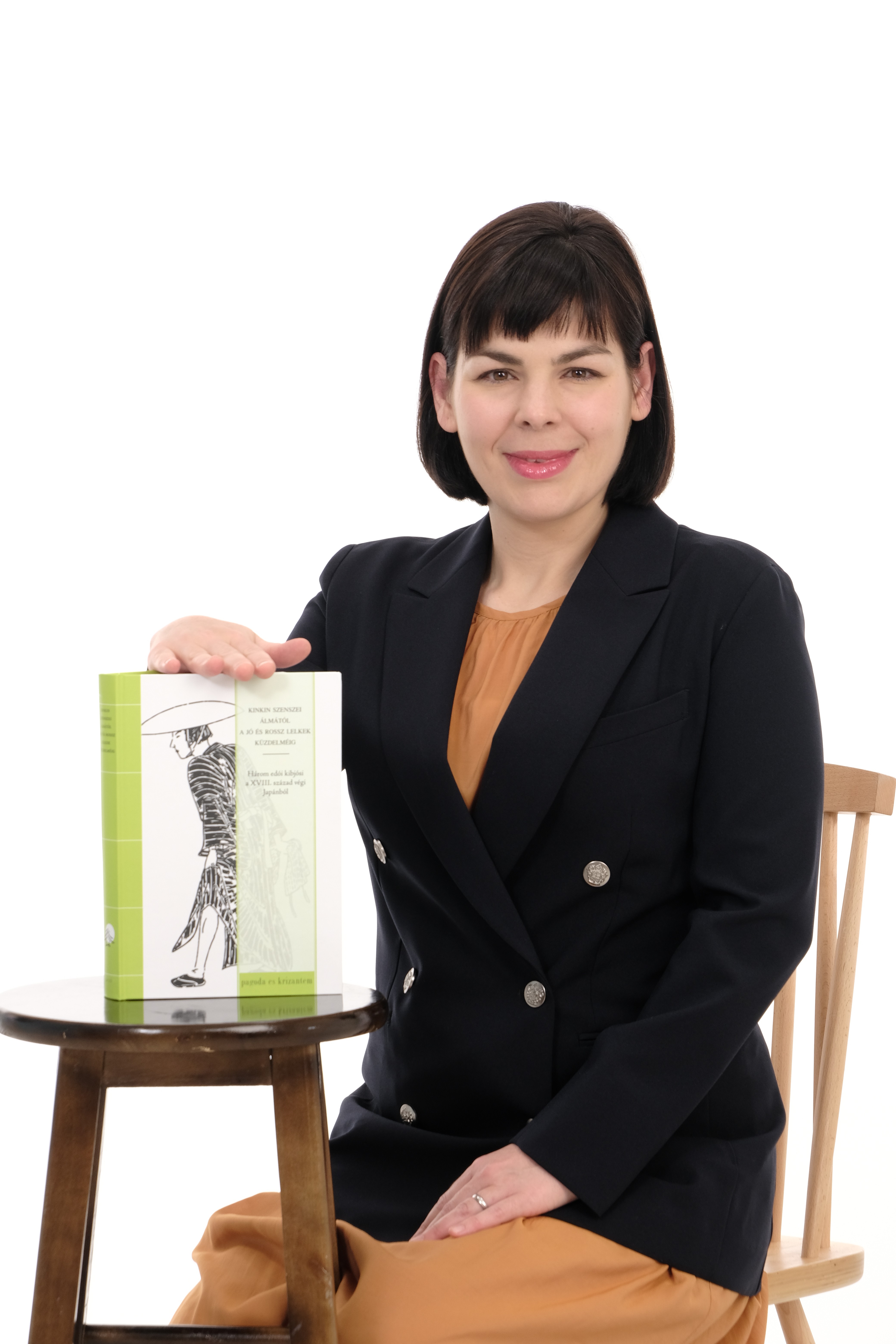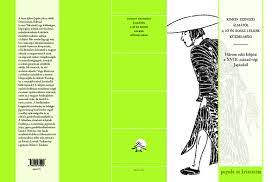2021
Review of "From the dream of Kinkin Sensei to the struggle of good and evil souls. Three Edo Kibyoshi from late 18th century Japan"
The translator of this volume, Andrea Csendom, after years of research in Japan, has done a heroic job, not only in translating the texts, but also in writing the notes, commentaries and accompanying essay. In particular, she has done an admirable job of tracking down many of the then well-known but now vanished phenomena of Edo, the fashion capital of the time, which are of course referred to in the kibyoshi as things that everyone knows: what fashionable men's clothing was like, even if it lasted only a few years (fashion changed very quickly, not only in everyday but also in literary terms, and the kibbutzim only lasted about a year or so), and how it was worn by men. What were the most cultivated fabrics, what kind of inns were frequented, what kind of food was eaten there, what holidays were celebrated, what were the popular gambling games, what kind of Edo shops are mentioned (these were often written into the kibyoshi for advertising purposes), what was the entertainment quarter, the stratified society of Yoshiwara, how the prostitutes of Yoshiwara spoke, what classic literary works are quoted, which famous Kabuki actor can be identified from a reference. The social, philosophical and religious background of the kibyoshi and the stylistic elements of the works are also remarkable.
See the full text in Hungarian here.
Gacsályi, A. (2023). Három Edo-kori kibyōshi fordítása és értelmezése: Csendom Andrea: Kinkin szenszei álmától a jó és rossz lelkek küzdelméig – Három edói kibjósi a XVIII. század végi Japánból. Budapest: Ráció Kiadó, 2021. Távol-Keleti Tanulmányok, 15(1), 301–304. Teljes szöveg itt.
„A Kinkin szenszei álmától a jó és rossz lelkek küzdelméig című kötet hiány-pótló gyűjtemény az irodalomtudomány és a japanológia terén egyaránt. A kiválasztott műveket precíz alapossággal elemzi, emellett átgondoltan és logikusan fűzi össze az egyes részeket. A kibyōshi Európában eddig csupán angol és német nyelven jelent meg, ezért a magyar nyelvű változat nem csak Magyarországot tekintve meghatározó. A könyv bárki számára érdekes lehet, aki érdeklődik a japán irodalom iránt, hiszen a szöveg közérthető, és magyarázatokkal egészül ki. A fordításokon és a kísérőtanulmányon keresztül az olvasó mélyebben meg-ismerkedhet az Edo-kori irodalom egyik sajátos műfajával.”
Gacsályi, A. (2023). Translation and interpretation of three Edo-period kibyōshi: Andrea Csendom: From the Dream of Kinkin Sensei to the Fight between Good and Bad Souls: Hungarian Translation of Three Kibyōshi from the End of the 18th Century. Ráció Publishing, 2021. Far Eastern Studies, 15(1), 301-304 . Full text here.
„From the Dream of Kinkin Sensei to the Fight between Good and Bad Souls is a groundbreaking collection in both literary studies and Japanese studies. The chosen works undergo meticulous analysis, with sections thoughtfully and logically interconnected. Notably, kibyōshi has only been published in English and German in Europe thus far, making the Hungarian version significant beyond Hungary’s borders. This book holds appeal for those interested in Japanese literature, offering accessible texts accompanied by explanations. Through these translations and the accompanying scholarly examination, readers can delve deeper into one of the distinctive genres of Edo-period literature.”
Gacsályi, A. (2023) 「江戸時代の三題詩の翻訳と解釈:チェンドム・アンドレら作『金々先生の夢から善玉と悪玉の喧嘩まで ―江戸中期の3編の黄表紙のハンガリー語訳―』 . Budapest: Ráció Kiadó, 2021. Far Eastern Studies, 15(1), 301-304. 全文はこちらから。
『金々先生の夢から善玉と悪玉の喧嘩まで ―江戸中期の3編の黄表紙のハンガリー語訳― 』は、文学研究においても日本研究においても画期的な作品集である。厳選された作品は緻密に分析され、各セクションは慎重かつ論理的に織り交ぜられています。ヨーロッパでは、これまで黄表紙は英語とドイツ語でしか出版されていませんでした。この書籍は、テキストには解説が付属しているので、日本文学に興味を持つ読者にとって魅力的です。翻訳と付随する研究論文を通じて、読者は江戸時代の文学の特有なジャンルの一つをより深く理解することができます。
Major Academic Papers
Hungarian Publications
1. Csendom, Andrea (2024)
„Zárt ország” az Edóiak szemszögéből – Hogyan vélekedtek a 18. századi humoros irodalomolvasói „idegen országokról”? (“Closed Country” from the Perspective of Edo Residents – How Did Readers of 18th-Century Humorous Literature Perceive ‘Foreign Nations’”) In. Kortárs Japanológia V. (Contemporary Japanology V.), pp. 277–296.
2. Csendom, Andrea (2024)
Kinkin szenszei álmától a jó és rossz lelkek küzdelméig: Három edói kibjósi a XVIII. század végi Japánból (From Kinkin Sensei's Dream to the Struggles of Good and Evil Spirits: Three Edo-Period Kibyōshi from Late 18th Century Japan). Ráció Kiadó.
3. Csendom, Andrea (2020)
A Kansei-kori kibyōshi eszmetörténeti elhelyezése és fordítási lehetőségeinek vizsgálata: Forráselemzés a kutatástörténet kiegészítéséhez (The Kibyōshi of Reform-period in the Context of History of Thought, and Exploring its Translation Method: Source Analysis to Complement Research History), Doctoral Dissertation, Eötvös Loránd University. DOI: 10.15476/ELTE.2020.052
4. Csendom, Andrea (2017)
“A terhesség és magzatkép az Edo-kor második felében: törvényeken, ōraimonokon és Kyōden gesakuján keresztül”(Pregnancy and Fetal Imagery in Late Edo Period: Through Laws, ōraimono, and Kyōden's Gesaku) In. Távol-keleti Tanulmányok 2018/1: 119–147
5. Csendom, Andrea (2013)
“A könyv szerepe az Edo-kori társadalom átalakulásában: A Régi szedett nyomtatás Japánban 1590–1640 között” (The Role of Books in Edo Society's Transformation: Early Printed Texts in Japan, 1590–1640) In: Közel ’s Távol (Near and Far) III. Proceedings of the ELTE Oriental and East Asian Studies Workshop, pp. 125–154.
English Publications
1. Csendom, Andrea (2024)
“Culture of Satire? Commoners’ Perspectives on Samurai Education in Late 18th Century Edo through Gesaku Literature” In. Journal of Linguistic and Cultural Studies (JOLCS), vol. 61, no. 2.
2. Csendom, Andrea (2025) (forthcoming).
“Women in Late 18th-Century Edo: A Framework Blending Japanese Kibyōshi and Western Intercultural Competencies” In. Asian Studies, vol. 79, no. 3.
3. Csendom, Andrea (2025) (forthcoming).
“Translating and Reimagining Edo-Era Graphic Narratives for Modern Global Audiences” In. Orpheus Noster (Károli Gáspár University)
Japanese Publications
1. チェンドム・アンドレア (2025) (forthcoming).
「大学教育におけるiDMCモデル ―動画制作を通じた日本文化発信と異文化理解の促進―」(iDMC Models in University Education: Promoting Japanese Cultural Understanding and Intercultural Competence through Video Creation)『第37回日本語教育連絡会議論文集』(Proceedings of the 37th Japanese Language Education Liaison Conference).
2. チェンドム・アンドレア (2025) (forthcoming).
「バイリンガル子育からみた日本語教育方法 ―言語発達と保護者の指導法に関するオンライン調査から得た、日本語教育への新たな視点―」(Perspectives on Japanese Language Education for Bilingual Children: Insights from an Online Survey on Language Development and Parental Guidance Methods)『AJEシンポジウム論文集』(AJE Symposium Proceedings 28).
3. チェンドム・アンドレア, 岡田昭人 (2024)
「動画作成を通じた異文化理解と語学教育の効果: ユーチューブ活用の実践」
(The Effects of Intercultural Understanding and Language Education Through Video Creation: Practices Using YouTube)『国際関係論叢』, Vol. 13, No. 2.
4. チェンドム・アンドレア (2023)
「『よしの冊子』からみる江戸の読者と黄表紙 ― 武士戯作者の引退の背景を探る」(Yoshi no Sōshi kara miru Edo no Dokusha to Kibyōshi: Bushi Gesakusha no Intai no Haikei wo Saguru) 文論 (Bunron – 日本文学研究ジャーナル), Heidelberg University, 10号, 1–17頁. DOI: https://doi.org/10.11588/br.2023.10.23265
5. チェンドム・アンドレア (2016)
「寛政改革を肯定する黄表紙?:『太平権現鎮座始』の翻刻と解釈への試み」
(Kansei-era Kibyōshi Supporting Reforms? Reprinting and Interpretation of Tahei Kengon Chinza Hajime)『書物・出版と社会変容』, 研究会, Vol. 20, pp. 279–315.
6. チェンドム・アンドレア (2015)
「黄表紙の批判性の再考:青砥藤綱像を使用する寛政年間の黄表紙をめぐって」
(Revisiting the Criticism of Kibyōshi: Exploring Aoto Fujitsuna's Representation in Kansei-era Kibyōshi)『第38回国際日本文学研究集会会議録』 (Proceedings of the 38th International Conference on Japanese Literature), 国文学研究資料館, 47–60頁.
7. チェンドム・アンドレア (2015)
「青砥藤綱像の形成:『太平記評判秘伝理尽鈔』と『北条九代記』の解釈を中心に」(The Formation of Aoto Fujitsuna’s Image: Focusing on Interpretations in Taheiki Hyōban Hiden Rijinzō and Hōjō Kyudaiki)『書物・出版と社会変容』, 研究会, Vol. 19, pp. 43–72.
8. チェンドム・アンドレア (2015)
「青砥藤綱像の変容からみた寛政期の文学上の人物の思想史的解釈をめぐって」(The Transformation of Aoto Fujitsuna in the Kansei Era: Philosophical Interpretations of Literary Characters) 修士論文 (Master’s Thesis), 一橋大学大学院, 言語学研究科 (Graduate School of Linguistics, Eötvös Loránd University).

